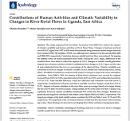| dc.contributor.author | Charles, Onyutha | |
| dc.contributor.author | Resty, Nyesigire | |
| dc.contributor.author | Anne, Nakagiri | |
| dc.date.accessioned | 2023-10-11T07:10:09Z | |
| dc.date.available | 2023-10-11T07:10:09Z | |
| dc.date.issued | 2021-09 | |
| dc.identifier.citation | Onyutha, C., Nyesigire, R., & Nakagiri, A. (2021). Contributions of human activities and climatic variability to changes in River Rwizi Flows in Uganda, East Africa. Hydrology, 8(4), 145. | en_US |
| dc.identifier.uri | https://doi.org/10.3390/hydrology8040145 | |
| dc.identifier.uri | https://hdl.handle.net/20.500.12504/1445 | |
| dc.description.abstract | This study employed Soil and Water Assessment Tool (SWAT) to analyze the impacts
of climate variability and human activities on River Rwizi flows. Changes in land use and land
cover (LULC) types from 1997 to 2019 were characterized using remotely sensed images retrieved
from Landsat ETM/TM satellites. SWAT was calibrated and validated over the periods 2002–2008
and 2009–2013, respectively. Correlation between rainfall and river flow was analyzed. By keeping
the optimal values of model parameters fixed while varying the LULC maps, differences in the
modeled flows were taken to reflect the impacts of LULC changes on rainfall–runoff generation.
Impacts due to human activities included contributions from changes in LULC types and the rates
of water abstracted from the river as a percentage of the observed flow. Climate variability was
considered in terms of changes in climatic variables such as rainfall and evapotranspiration, among
others. Variability of rainfall was analyzed with respect to changes in large-scale ocean-atmosphere
conditions. From 2000 to 2014, the portion of River Rwizi catchment area covered by cropland
increased from 23.0% to 51.6%, grassland reduced from 63.3% to 37.8%, and wetland decreased from
8.1% to 4.7%. Nash–Sutcliffe Efficiency values for calibration and validation were 0.60 and 0.71,
respectively. Contributions of human activities to monthly river flow changes varied from 2.3% to
23.5%. Impacts of human activities on the river flow were on average found to be larger during
the dry (14.7%) than wet (5.8%) season. Using rainfall, 20.9% of the total river flow variance was
explained. However, climate variability contributed 73% of the river flow changes. Rainfall was
positively and negatively correlated with Indian Ocean Dipole (IOD) and Niño 3, respectively. The
largest percentages of the total rainfall variance explained by IOD and Niño 3 were 12.7% and 9.8%,
respectively. The magnitude of the correlation between rainfall and IOD decreased with increasing
lag in time. These findings are relevant for developing River Rwizi catchment management plans. | en_US |
| dc.language.iso | en | en_US |
| dc.publisher | MDPI | en_US |
| dc.subject | Climate variability | en_US |
| dc.subject | Hydrological modeling | en_US |
| dc.subject | Land-use or land cover (LULC) changes | en_US |
| dc.subject | Rainfall–runoff | en_US |
| dc.subject | River Rwizi catchment | en_US |
| dc.subject | SWAT | en_US |
| dc.subject | Uganda | en_US |
| dc.title | Contributions of human activities and climatic variability to changes in river Rwizi flows in Uganda, East Africa | en_US |
| dc.type | Article | en_US |

